Intel Core i7-10700 vs Core i7-10700K Review: Is 65W Comet Lake an Option?
by Dr. Ian Cutress on January 21, 2021 10:30 AM EST- Posted in
- CPUs
- Intel
- Core i7
- Z490
- 10th Gen Core
- Comet Lake
- i7-10700K
- i7-10700
CPU Tests: Legacy and Web
In order to gather data to compare with older benchmarks, we are still keeping a number of tests under our ‘legacy’ section. This includes all the former major versions of CineBench (R15, R11.5, R10) as well as x264 HD 3.0 and the first very naïve version of 3DPM v2.1. We won’t be transferring the data over from the old testing into Bench, otherwise it would be populated with 200 CPUs with only one data point, so it will fill up as we test more CPUs like the others.
The other section here is our web tests.
Web Tests: Kraken, Octane, and Speedometer
Benchmarking using web tools is always a bit difficult. Browsers change almost daily, and the way the web is used changes even quicker. While there is some scope for advanced computational based benchmarks, most users care about responsiveness, which requires a strong back-end to work quickly to provide on the front-end. The benchmarks we chose for our web tests are essentially industry standards – at least once upon a time.
It should be noted that for each test, the browser is closed and re-opened a new with a fresh cache. We use a fixed Chromium version for our tests with the update capabilities removed to ensure consistency.
Mozilla Kraken 1.1
Kraken is a 2010 benchmark from Mozilla and does a series of JavaScript tests. These tests are a little more involved than previous tests, looking at artificial intelligence, audio manipulation, image manipulation, json parsing, and cryptographic functions. The benchmark starts with an initial download of data for the audio and imaging, and then runs through 10 times giving a timed result.
We loop through the 10-run test four times (so that’s a total of 40 runs), and average the four end-results. The result is given as time to complete the test, and we’re reaching a slow asymptotic limit with regards the highest IPC processors.

Google Octane 2.0
Our second test is also JavaScript based, but uses a lot more variation of newer JS techniques, such as object-oriented programming, kernel simulation, object creation/destruction, garbage collection, array manipulations, compiler latency and code execution.
Octane was developed after the discontinuation of other tests, with the goal of being more web-like than previous tests. It has been a popular benchmark, making it an obvious target for optimizations in the JavaScript engines. Ultimately it was retired in early 2017 due to this, although it is still widely used as a tool to determine general CPU performance in a number of web tasks.
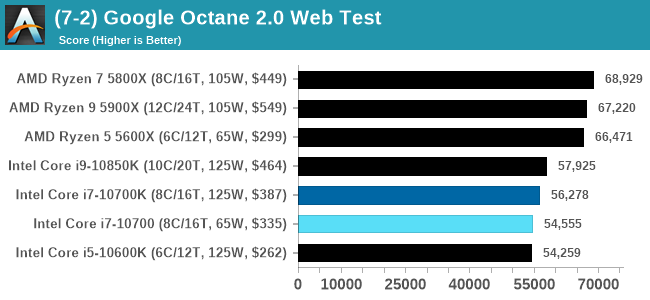
Speedometer 2: JavaScript Frameworks
Our newest web test is Speedometer 2, which is a test over a series of JavaScript frameworks to do three simple things: built a list, enable each item in the list, and remove the list. All the frameworks implement the same visual cues, but obviously apply them from different coding angles.
Our test goes through the list of frameworks, and produces a final score indicative of ‘rpm’, one of the benchmarks internal metrics.
We repeat over the benchmark for a dozen loops, taking the average of the last five.
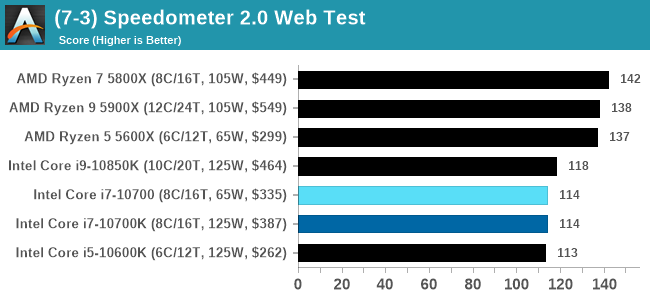
Legacy Tests
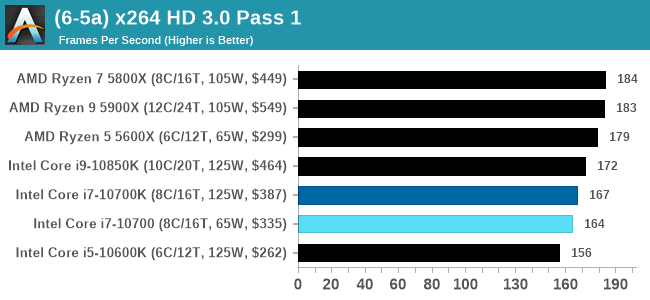
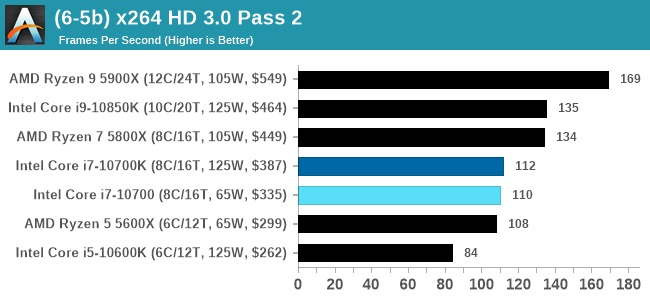
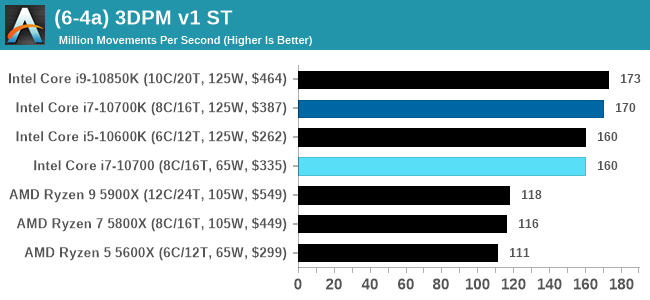
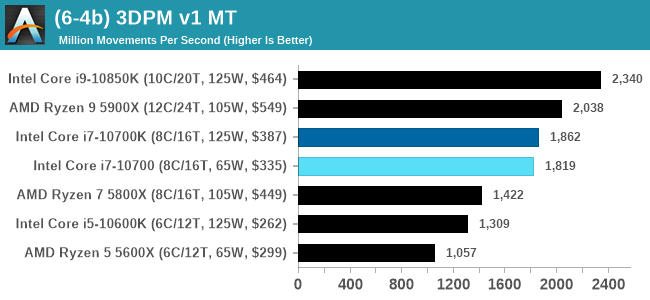
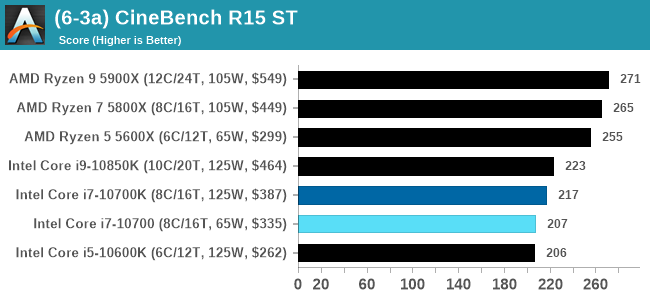
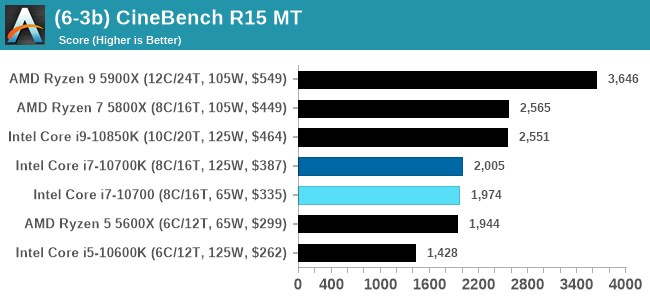


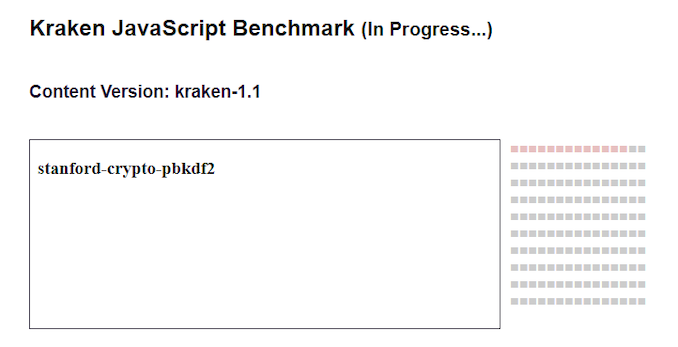
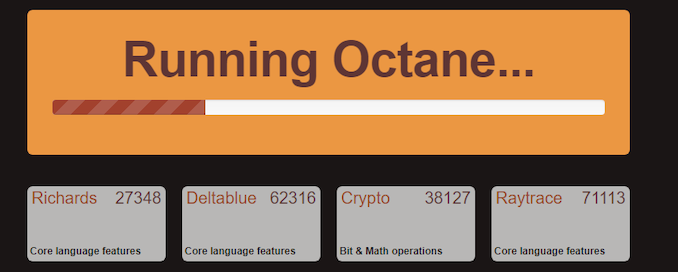
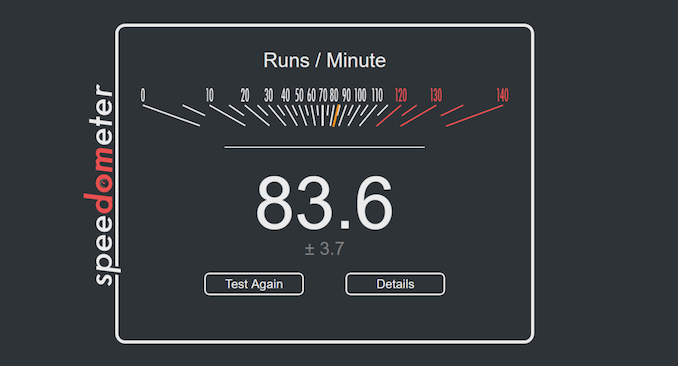








210 Comments
View All Comments
Samus - Friday, January 22, 2021 - link
I don't think ANYONE actually wants to see the numbers for these chips at 65W :)Spunjji - Monday, January 25, 2021 - link
I love a good laugh!iAPX - Saturday, January 23, 2021 - link
I totally agree, a 5600X and a 10700 on their 65W TDP, and their maximum performance, to gives a baseline of what performance-level is WARRANTED by their makers.etal2 - Thursday, January 21, 2021 - link
Setting the limits in the bios is very nice and all but without the voltage regulation and thermal capacity they can not sustain this performance for very long regardless of the numbers set.I very much doubt that on the 60$ cheap 4 phase vrm boards the manufacturers set the limits very high, they will get fried boards within the warranty period and we know very well they can't have that.
Spunjji - Friday, January 22, 2021 - link
That would be nice to see. Perhaps an article showing which of a representative selection of processors provide the best performance at a given set of fairly common power levels (65W / 95W / 125W).Something for when Dr Cutress finds himself with infinite time and no impending deadlines 😅
u.of.ipod - Thursday, January 21, 2021 - link
So happy I waited patiently and got a Ryzen 5600x for my small form factor system. The fact it can hang with the i7's and only consumes 1/3 the peak power draw is great for heat output and playing nicely with SFX PSUs.Golgatha777 - Thursday, January 21, 2021 - link
And that's how you end up with graphs like this one.https://cdn.mos.cms.futurecdn.net/i9W8M8HgGaTqRs4b...
Spunjji - Friday, January 22, 2021 - link
Oof.Samus - Friday, January 22, 2021 - link
Oof.magreen - Friday, January 22, 2021 - link
Pentium 4 Extreme Edition all over again